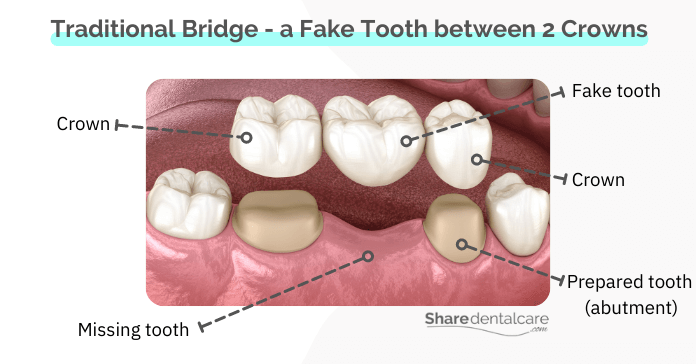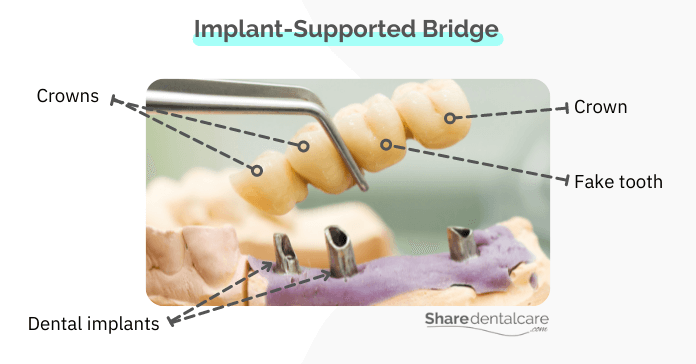Dental bridges are fixed prostheses that are used to replace missing teeth whether one or many. The dental bridge has a fake tooth (pontic) that fills in the gap created by a missing tooth. The fake tooth is held in place by two or more crowns (abutments) on either side of the gap. Dental bridges can be made from metal, porcelain, or a combination of both. In this article, we will discuss how the dental bridge and fake tooth work and what are the different types.
How Do The Dental Bridge & Fake Tooth Work?
The dental bridge consists of 2 or more crowns holding a fake tooth or teeth in between. The fake tooth is known as pontic. The crowns are cemented to natural teeth or implants on either side of the gap. These natural teeth or implants, also known as abutments, provide support for the pontic and bridge. The fake tooth (pontic) restores the function and appearance of the missing tooth, enabling you to eat, speak, and smile with confidence. In most cases, dental bridges are made from porcelain to match your original teeth’ color and shape.
Dental bridges are usually supported by two or more natural teeth or implants. However, if only one natural tooth supports the fake tooth, then the bridge is known as a cantilever bridge. Learn more about different bridge types in dentistry.
What are the Different Types of Dental Bridges?
There are various types of dental bridges, and each has its benefits. It is crucial to know about the different types to choose the best one for your individual needs.
Traditional Dental Bridge – Fake Tooth is Supported from Both Sides
The traditional bridge is one of the most common prostheses used in dentistry. A traditional bridge consists of a fake tooth (pontic) that is supported by two or more natural teeth on both sides of the gap. The pontic is held in place by crowns that are cemented to adjacent natural teeth (abutments).
Traditional bridges are strong, durable, and can last a long time with proper care. However, they require the preparation of two or more adjacent teeth, which can cause damage to them. Learn more about a bridge for back teeth.

Cantilever Bridge – Fake Tooth is Supported from One Side
The cantilever bridge is a type of dental bridge that consists of a false tooth (pontic) supported by one or more natural teeth or implants on one side. The other side is left to hang in the air.
For example, a cantilever bridge is suitable for missing upper lateral incisors. In this case, it will get support from the adjacent canine because the biting force is low in the lateral incisor region. Cantilever bridges aren’t suitable for places with high biting or chewing forces such as back teeth (molars) because they are not strong.
Maryland Bridge – Fake Tooth with Wings
The Maryland bridge, also known as an adhesive bridge, consists of a false tooth with 2 wings (metal framework) that attach to the backside of the front teeth. Maryland bridge is less invasive than the traditional bridge and can be used to restore front teeth (incisors). However, they can loosen easily. So, they can’t be used in areas with high force, such as back teeth (molars).
Implant-Supported Bridge – Fake Tooth is Supported by Implants
An implant-supported bridge is a type of dental bridge that relies on implants to support the fake tooth. The implant is anchored to the bone and serves as an abutment for the bridge. This kind of bridge is suitable for people who don’t have enough intact teeth to support a traditional bridge.
Implant-supported bridges are strong, durable, and can last a lifetime with proper care. However, they are more expensive and require surgical procedures.

Factors to Consider Before Having a Dental Bridge
Before choosing between the different types of dental bridges, you should consider the following factors.
- Cost: the implant-support bridge is more expensive than the traditional bridge.
- Durability: implant-supported bridges are more durable than other types.
- The number of missing teeth: cantilever and Maryland bridges are not suitable for people with several missing teeth. Learn more about a bridge for two missing teeth.
- The condition of existing teeth: traditional bridges are not suitable for patients who don’t have enough intact teeth to support the bridge.
- The condition of the jawbone: implant-supported bridges are not suitable for patients with an insufficient jawbone. In this case, the dentist may recommend bone grafting for dental implants. Learn more about different types of teeth replacement options.
Fake Tooth Bridge – Conclusion
Dental bridges are common prostheses used in dentistry. They are very useful when one or more teeth are missing. They can restore the function and appearance of your teeth. There are several types of dental bridges available, and each type has benefits and drawbacks. Before getting a fake tooth, It is important to know about the different types to choose the best one for your individual needs Talk to your dentist to know more and choose the one that’s right for you.